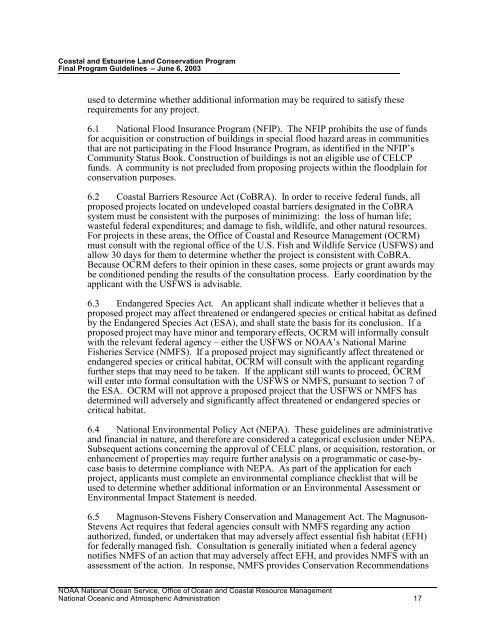Honu'apo Park Resource Management Plan
Honu'apo Park Resource Management Plan
Honu'apo Park Resource Management Plan
Create successful ePaper yourself
Turn your PDF publications into a flip-book with our unique Google optimized e-Paper software.
Coastal and Estuarine Land Conservation Program<br />
Final Program Guidelines – June 6, 2003<br />
used to determine whether additional information may be required to satisfy these<br />
requirements for any project.<br />
6.1 National Flood Insurance Program (NFIP). The NFIP prohibits the use of funds<br />
for acquisition or construction of buildings in special flood hazard areas in communities<br />
that are not participating in the Flood Insurance Program, as identified in the NFIP’s<br />
Community Status Book. Construction of buildings is not an eligible use of CELCP<br />
funds. A community is not precluded from proposing projects within the floodplain for<br />
conservation purposes.<br />
6.2 Coastal Barriers <strong>Resource</strong> Act (CoBRA). In order to receive federal funds, all<br />
proposed projects located on undeveloped coastal barriers designated in the CoBRA<br />
system must be consistent with the purposes of minimizing: the loss of human life;<br />
wasteful federal expenditures; and damage to fish, wildlife, and other natural resources.<br />
For projects in these areas, the Office of Coastal and <strong>Resource</strong> <strong>Management</strong> (OCRM)<br />
must consult with the regional office of the U.S. Fish and Wildlife Service (USFWS) and<br />
allow 30 days for them to determine whether the project is consistent with CoBRA.<br />
Because OCRM defers to their opinion in these cases, some projects or grant awards may<br />
be conditioned pending the results of the consultation process. Early coordination by the<br />
applicant with the USFWS is advisable.<br />
6.3 Endangered Species Act. An applicant shall indicate whether it believes that a<br />
proposed project may affect threatened or endangered species or critical habitat as defined<br />
by the Endangered Species Act (ESA), and shall state the basis for its conclusion. If a<br />
proposed project may have minor and temporary effects, OCRM will informally consult<br />
with the relevant federal agency – either the USFWS or NOAA’s National Marine<br />
Fisheries Service (NMFS). If a proposed project may significantly affect threatened or<br />
endangered species or critical habitat, OCRM will consult with the applicant regarding<br />
further steps that may need to be taken. If the applicant still wants to proceed, OCRM<br />
will enter into formal consultation with the USFWS or NMFS, pursuant to section 7 of<br />
the ESA. OCRM will not approve a proposed project that the USFWS or NMFS has<br />
determined will adversely and significantly affect threatened or endangered species or<br />
critical habitat.<br />
6.4 National Environmental Policy Act (NEPA). These guidelines are administrative<br />
and financial in nature, and therefore are considered a categorical exclusion under NEPA.<br />
Subsequent actions concerning the approval of CELC plans, or acquisition, restoration, or<br />
enhancement of properties may require further analysis on a programmatic or case-bycase<br />
basis to determine compliance with NEPA. As part of the application for each<br />
project, applicants must complete an environmental compliance checklist that will be<br />
used to determine whether additional information or an Environmental Assessment or<br />
Environmental Impact Statement is needed.<br />
6.5 Magnuson-Stevens Fishery Conservation and <strong>Management</strong> Act. The Magnuson-<br />
Stevens Act requires that federal agencies consult with NMFS regarding any action<br />
authorized, funded, or undertaken that may adversely affect essential fish habitat (EFH)<br />
for federally managed fish. Consultation is generally initiated when a federal agency<br />
notifies NMFS of an action that may adversely affect EFH, and provides NMFS with an<br />
assessment of the action. In response, NMFS provides Conservation Recommendations<br />
NOAA National Ocean Service, Office of Ocean and Coastal <strong>Resource</strong> <strong>Management</strong><br />
National Oceanic and Atmospheric Administration 17


